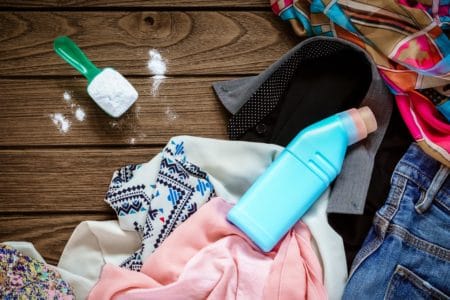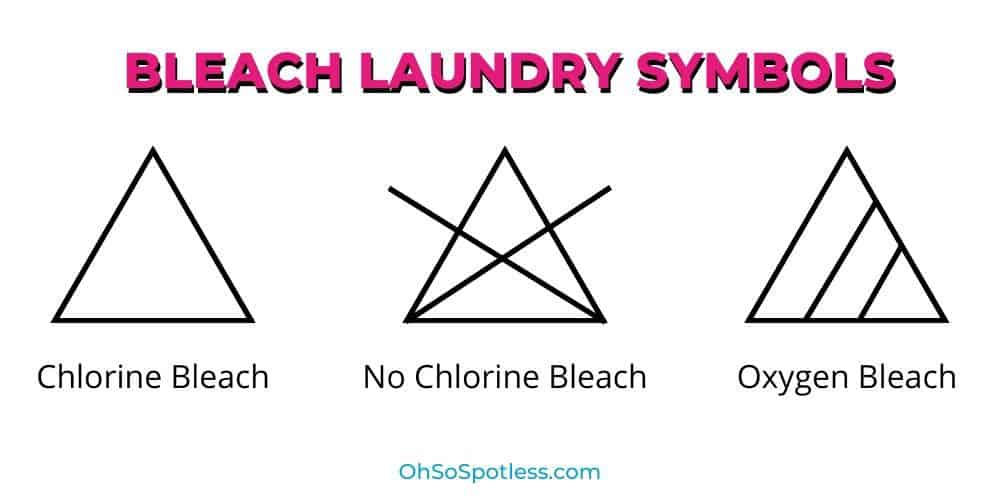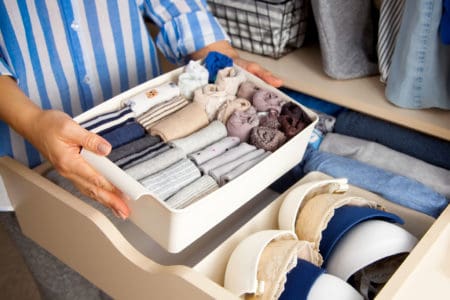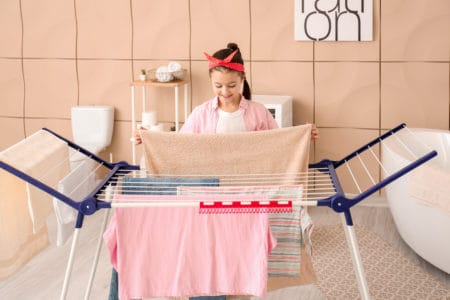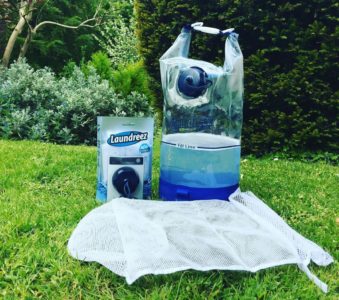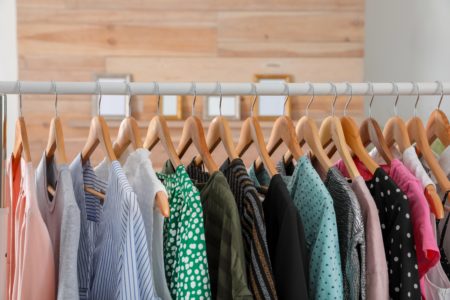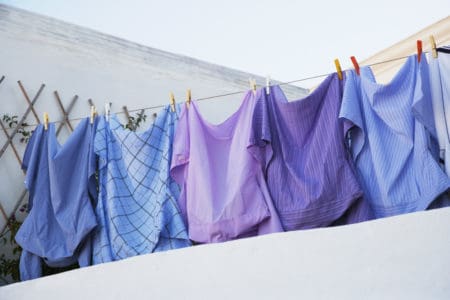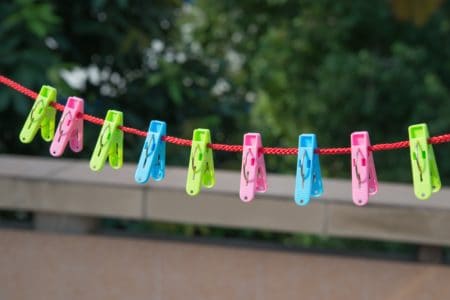Your washing machine loosens and removes dirt from clothes. If you’re lucky, a general wash will erase mud, food, or grass stains. But your washing machine and generic washing liquid don’t sanitize your clothes.
For that, you’ll need to know how to disinfect laundry. This is a vital skill for when you need to wash clothes after someone in the family has been ill.
We’ll show you the best methods for disinfecting laundry with or without bleach.
Key Takeaways
- Disinfect laundry to prevent illnesses and spread of germs, especially after a family member has been sick.
- Use bleach for white clothes, following clothing labels and adding the correct amount to the washer.
- For colored clothes, consider alternatives like Borax, essential oils, Pine-Sol, white vinegar, or hydrogen peroxide.
- High heat methods such as hot wash cycles, tumble drying, ironing, or steaming can also disinfect laundry effectively.
Do You Need to Disinfect Laundry?
If you want to prevent illnesses from spreading, yes. If you need to sanitize clothes after an unfortunate flood or mold outbreak, yes.
Brace yourself for some pretty disgusting — but important — facts.
According to a Time article, “A single gram of fecal matter contains millions of viruses, and exposure to just a hundred of those viruses can make you sick” (1).
Surprisingly, the average person has one-tenth of a gram of fecal matter on their underwear. This, in turn, spreads to 90 percent of the other items when put in a washing machine.
You might think, “Well, I’ll just wash my clothes separately from my housemate’s.”
Think again. Their germs still hang around in the washing machine even after they’ve removed their clothes.
All in all, the only way to prevent the spread of illnesses is to disinfect your laundry.
How to Disinfect Laundry With Bleach
Bleach is an effective way to kill bacteria and stop the spreading of illnesses. However, be careful when using bleach on colored items because it can cause discoloration.
- Time: Five minutes.
- Difficulty: Easy.
Warning
What You’ll Need
- Bleach.
- White clothes (preferable).
- Normal laundry detergent.
- Washing machine.
Using Bleach to Disinfect Laundry
- Choose the right bleach: Make sure your bleach has between 5.25 and 6.15 percent of sodium hypochlorite. We recommend Clorox Splash-Less.
- Read clothing labels: Bleach works in cold, warm, or hot washes, but your garment might only be suitable for cold water. Check the care label for temperature guidance.
- Add bleach before clothes: For a regular load of lightly soiled laundry, add ¾ cup of bleach to the bleach dispenser. If this isn’t possible, add bleach to the machine as it fills up with water before the laundry is added. For heavily soiled clothes, use 1.25 cups of bleach instead.
- Add detergent: Add the normal amount of detergent to the wash.
- Wash: Run the cycle.
The bleach will remove up to 99.9 percent of germs and bacteria. It’s also great for cleaning your washing machine once a month to prevent the further spreading of illnesses.
How to Disinfect Laundry Without Bleach
Of course, bleach works best for white clothes. So, if you’re wondering how to kill germs and bacteria on your dark work uniform or your little black dress, look no further than this list!
Borax
Borax is an excellent alternative to bleach since it’s a disinfectant and antifungal.
- Read clothing labels: Since Borax works best with hot water, make sure you only use it on clothes that can be washed at hot temperatures.
- Add Borax to detergent: For a regular load, add ½ cup of Borax to your detergent. Mix beforehand for a good consistency, so it doesn’t block your dispenser. Or, you can pour it into the machine with the clothes.
- Wash your clothes hot: Make sure to do a hot wash cycle. Don’t use Borax on a rinse cycle, and don’t use cool or warm water.
Caution
Essential Oils
Essential oils are great for sanitizing your laundry. Simply add them to the fabric conditioner dispenser in your machine or straight to the load during the wash.
The following essential oils work particularly well for sanitizing laundry:
- Pine oil: Add one cup of pine oil to your wash. The more you use, the cleaner your laundry will be! But don’t use pine oil on silk or wool. Pine oil has a distinct smell, so you might want to do an extra rinse to get the lingering smell out.
- Tea tree oil: 100 percent tea tree oil is an effective laundry disinfectant. To disinfect clothes, add two teaspoons of tea tree oil to your load.
- Lavender oil: This is antibacterial, antifungal, and antiseptic. Add 10 drops to each load, and voila, blast bacteria away!
- Thyme oil: Thyme oil is known to kill E. coli and MRSA (2). Make sure you buy thyme oil twice distilled and don’t use it if pregnant. To use for sanitizing clothes, add about one teaspoon.
Keep In Mind
Pine-Sol
Pine-Sol is a great alternative to bleach. You can also use it for other cleaning chores, such as cleaning carpets or glass.
Besides its lovely scent, Pine-Sol kills 99.9 percent of germs and bacteria (3). You can use this product to get out stains, but if you want to disinfect your laundry, follow these steps:
- Check your clothes: Only use on white or colorfast fabrics.
- Add your clothes: Put your laundry in the washing machine first.
- Add Pine-Sol: Add ½ cup of Pine-Sol to your laundry via the dispenser or drum.
- Wash: Run the washer at your desired cycle and temperature.
White Vinegar
Distilled white vinegar is another powerful, non-toxic disinfectant. If you have kids and pets at home or prefer less severe cleaning products, this might be a winner. You can use it as a mild disinfectant or a rinse cycle to remove soap buildup from your regular detergent.
Here’s how to disinfect laundry with white vinegar:
- Use white vinegar: Not regular or apple cider vinegar.
- Use it in a regular cycle: Add anywhere between ¼ cup and ½ cup in a regular wash or a rinse cycle.
- Wash: Run the washer at any temperature.
Hydrogen Peroxide
Hydrogen peroxide is a must-have product in the laundry room. Not only is it an effective sanitizer, but it whitens and brightens clothes and removes stains. Hydrogen peroxide has many amazing uses, but to disinfect laundry, follow these steps:
- Use 3 percent hydrogen peroxide: You can buy this in most drug stores.
- Spot test: Hydrogen peroxide works with whites and colors, but do a spot test first to ensure it doesn’t stain the fabric.
- Add one cup: Add to the detergent dispenser or straight into the drum for a disinfecting clean.
- Wash: Run the washer as usual.
How to Disinfect Laundry With Heat
You can use heat to sanitize your clothes. Some ways to do this include:
- Wash temperature: Wash your clothes at the hottest temperature possible. But check the label on each garment first, because some clothes shrink or lose color in hot water.
- Use your dryer: The heat from your dryer can kill bacteria that escaped the washing machine, especially if you washed your clothes in cold water.
- Iron your clothes: Prolonged exposure to the high heat from an iron will kill pathogens.
- Try a steamer: To further sanitize your laundry, try a handheld steamer. Simply wave it over your clothes to kill bacteria and get out wrinkles. It’s a win-win!
Does the Dryer Disinfect Clothes?
Yes, your tumble dryer kills pathogens. Even a 30-minute cycle at high heat can do an excellent job of disinfecting your laundry (4).
If you want to save energy, you can always hang your clothes outside in the sun to dry since UV light is a natural disinfectant.
How Do You Disinfect Colored Clothes?
Borax, white vinegar, and other laundry detergent alternatives will disinfect your colored clothes. You can be sure you won’t lose the brightness and pigment of your favorite pieces.
The ones to stay away from when disinfecting colors are:
- Bleach.
- Hydrogen Peroxide (unless a spot test proves otherwise).
The rest are safe to use, but always read the label on your clothes to know which temperature to use for individual garments.
Does Vinegar Sanitize Laundry?
White vinegar will disinfect your laundry because of its acidic quality. As well as sanitizing, it deodorizes and keeps colors bright (5). So, add some white vinegar next time you do laundry and watch the magic happen.
